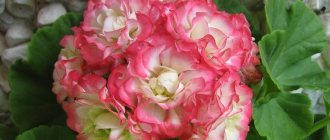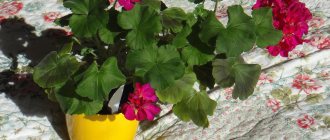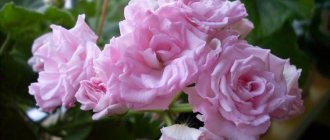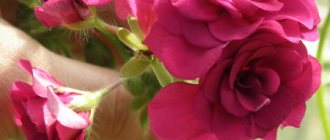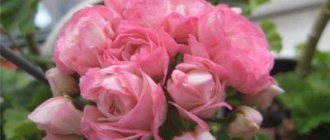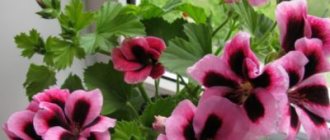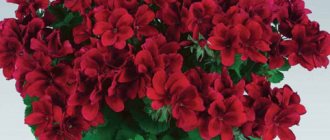Description and cultivation
The birthplace of pelargonium is South Africa. There are about 400 species of this flower: some of them formed in nature, some were bred by breeders.
Terry type geranium belongs to the zonal variety. It is distinguished by strong straight stems. The foliage is lush, the leaves often have a border: in some varieties it is clearly expressed, in others it is almost invisible.
In double varieties, each flower consists of more than 8 petals (from 6 to 8 - semi-double varieties). They are often collected in round, dense inflorescences.
Home care is easy. The main thing is good lighting. Pelargonium should be watered as the soil dries out - overwatering is very harmful for it. Frequent transplants are undesirable; geranium reacts poorly to them.
General information
The flower was brought to Europe from hot Africa. When the ships of traders, rounding the south of the continent, stopped to replenish their water supplies, they were surprised by an amazing plant growing among the wild nature. In the 18th century, pelargonium began to be actively grown in Europe, and then it spread to other countries of the world.
Sometimes the plant is confused with geranium, but their flowers differ in structure. Geranium has 5 completely identical petals, while pelargonium has upper and lower petals of different volumes and shapes, their color scheme is more complex due to its heterogeneity.
Botanists describe Denise pelargonium as a perennial shrubby plant with straight or branched stems. It has palmate leaves and umbrella-shaped inflorescences and surprises with endless variations of pink color. The capsule fruit opens from the bottom up and releases the seeds.
The influence of southern origin was reflected in the climatic preferences of the African beauty. It easily tolerates drought, but cannot winter in open ground.
Pelargonium is not only a beautiful, but also a useful plant. Essential oils contained in the leaves are used in cosmetology. And based on the root extract, pharmacists produce medicines for the treatment of the upper respiratory tract.
The best varieties
Let's look at the description of the most interesting varieties.
Royal sovereign
Pelargonium Royal sovereign is distinguished by bright red flowers. The flowering is lush. The leaves are decorative, with a wide bronze circle in the center - smooth on the inside and “spreading” along the veins on the outside. For it to be pronounced, the plant must receive enough light.
Edwards pleasure
Pelargonium Edwards pleasure has large salmon-colored flowers collected in caps. Their shape is interesting, reminiscent of half-opened tulips. Flowering is abundant and does not require additional stimulation.
orange glitter
The variegated flowers of the Orange glitter variety are very interesting: light pink, with bright orange specks and dashes. The hats are tight and large. The bush is lush, with bright green succulent leaves. Orange glitter blooms abundantly and lushly.
Charmay cockey
The Charmay cockey variety is distinguished by delicate flowers, juicy pink in the center and lighter towards the edges. Petals with a thin bright edging. The light part can be white or pale pink. The bush is compact.
If you like flowers with a uniform pink color, consider Bold rose and Jagershus gogodansaren pelargoniums.
Asarnas asgard
Pelargonium Asarnas asgard is distinguished by super-double, very lush flowers. The petals are white, folded, with a slight pink tint and bright pink specks. The inflorescences of Asarnas asgard are dense and large. Peduncles are short and strong.
Some gardeners note that Asarnas asgard blooms reluctantly, and that care for this geranium should be especially attentive. According to a number of reviews, in order for the pelargonium Asarnas asgard to bloom, it needs fairly dense soil. The Asarnas asgard bush grows relatively slowly.
Vastanbyn
Vastanbyn flowers look very impressive due to their rich raspberry-fuchsia hue (the color of a thick solution of potassium permanganate). The bush responds well to shaping. The hats are big.
Gardenia
Gardenia pelargonium flowers look elegant and delicate due to their pure white color. The variety keeps flowering for a long time. A Gardenia bush can form beautifully after the first pinching.
Double pink bird's egg
Geranium Double pink bird's egg belongs to the subgroup “bird eggs” - this is the name given to the speckled color of the petals of some pelargoniums for their resemblance to the eggs of wild birds.
This variety has soft pink petals (the shade of orchid pink), with hints of white coming from the center. The specks are red-pink. The bush is large.
Eras Silva
Eras silva belongs to the so-called carnation pelargoniums. Its lavender-pink petals have jagged edges like a carnation. The center of the flower is white.
The bush is compact and strong, with large pubescent leaves. The stems are thick and strong. It lends itself well to shaping, blooms easily, and does not fade in winter.
Plum desert
The Plum desert variety is very beautiful and effective. It is distinguished by unusual rose flowers, which at the first stage of dissolution really resemble small roses. The color of the “roses” is rich, dark purple. They do not fade in the sun.
Plum desert is characterized by a compact bush and somewhat fragile shoots. The leaves are small. The variety is sensitive to watering; if there is a lack of moisture, it can dry out the buds, so you need to care for it especially carefully.
Martha
Dwarf geranium Martha has white flowers that do not turn pink in the sun. The inflorescences are large, dense and lush.
The leaves are small, pubescent, with a uniform color. The bush is compact, grows slowly, and branches well. It does not withstand direct sunlight as well as other varieties of geranium.
South african sun
The bright red flowers of South African sun pelargonium look especially elegant against the background of golden-green foliage. The shade gives the impression of radiance (hence the “sunny” name). Flowering is abundant. The South African sun bush is compact and branches well.
Description of the pelargonium variety Sutarve Clara San and its characteristics
This flower is characterized by a thick cap of inflorescences, up to 3.5 cm in diameter; the flowers are very similar to roses. The color of the inflorescences is a gentle transition from pink to light green, from the edges of the petals to the center. The leaves are light green, rounded.
Delicate head of inflorescences Klara San
Pelargonium grows especially actively in the first year of its life. It is important to place it in a tight pot so that it grows green mass and not roots.
For your information! The variety went on sale almost immediately after its creation in 2016. The progenitor of the hybrid beauty is the Alpenbloss variety.
'Sutarves Clara San'
'Sutarves Clara San'
Post by NataK » Jul 10, 2013, 9:59 pm
Pelargonium 'Sutarves Klara San' (Sutarve) Zonal, rosaceous pelargonium. In my opinion, it must be a strong growing plant.
This is the first flowering, there are 11 flowers in the cap.
Grows on a south window. Pot - 10.
I really like the shape of the flower. Flower size - 3 cm.
We're not the only ones who love flowers:
Re: Clara San (Sutarve)
Post by Passific » Jul 10, 2013, 11:33 pm
Natalya, thank you for introducing me to this variety.
In shape and color, Klara San and Apple Blossom Rosebud are very similar. It will be very cool if Klara San is more discreet and compact, unlike Apple
Re: 'Klara San'
Post by Mila M » Jul 24, 2014, 4:56 pm
The variety is very beautiful!
Re: 'Klara San'
Post by midas » 07 Sep 2014, 00:37
Re: 'Klara San'
Post by MAK » 07 Sep 2014, 00:52
midas, and I have this variety that is much more compact than Apple Blossom Rosebud. True, their age and volume are different. This is how she grew up, her blossoms were paler, but there was less sun for her. Age - less than a year. And Apple Blossom Rosebud grew 2 liters and was 2 times healthier. Age 4 years. One hat is fresh, the second is already withered. Volume 1 liter.
Re: 'Klara San'
Post by midas » 07 Sep 2014, 01:21
Planting and replanting pelargonium Clara San
Pelargonium Sutarve Clara San is not too capricious in home care. After the adaptation period, the first year of flower care is very important.
Choosing a place and pot
For pelargonium, select the most illuminated place in the house. If it is a south-facing window, it is important to shade it from the midday sun with transparent paper or fabric.
The pot for pelargonium needs to be small, otherwise the flower will actively grow its root mass. Drainage plays the main role; pelargonium does not tolerate stagnation of moisture.
Priming
The soil mixture should be as light and nutritious as possible. Leaf soil is diluted with peat, sand and turf in equal parts.
Important! Planting pelargonium is a process no different from planting ordinary geranium.
Further care
To further care for Clara, it is important to focus on pruning, complementary feeding, hydration, and lighting.
Temperature
The optimal temperature in summer is 20-25 °C. In winter, not lower than 15 °C.
In summer, pelargonium grows well outdoors
Watering and spraying
The plant does not need spraying. The watering regime should be such that the substrate is constantly moist, but without stagnation of liquid in the roots. Watering is needed frequently and not abundantly.
Important! The plant has no special requirements for air humidity.
Loosening
If the soil is light enough, it is not necessary to loosen it. If a crust forms from frequent watering, loosen the soil in the pot from time to time.
Feeding
Fertilizers support the gorgeous and long-lasting flowering of Clara's pelargonium. Except for the winter period, complementary foods are introduced twice a month. Without proper nutrition, Clara san's buds may fall off during flowering.
It is important to know! Any complex fertilizers, except organic ones, can be used as fertilizers.
Trimming
Pruning in the first year shapes the size and compactness of the bush. Thanks to this procedure, the plant is given a beautiful shape. It also allows you to save energy for abundant flowering.
Description of the variety
Pelargonium Sutarves Klara San was selected in 2016. It has double flowers that are highly decorative; due to the small number of petals, the bud does not open completely.
Pelargonium Sutarve Clara San - an ideal plant for true romantics
- The inflorescences are shaped like roses. The petals are pink, the middle is light green. Diameter - 3 cm.
- The buds are collected in inflorescences.
- The leaves are large, rich green in color. Each rounded leaf rests on its own long stem.
- Flowering continues from March to early November.
- Fast growth rate, within a year the plant develops into an adult shrub.
Note! The more light there is in the place where pelargonium or geranium is planted, the brighter and more saturated the pink petals will be.
Appearance
The advantage of the variety is that Pelargonium Clara blooms in an unusual way: its inflorescences resemble small roses. The color of the petals is appropriate - very delicate pinkish with a light green center.
The diameter of one bud is 3.5 cm. The buds are collected in lush inflorescences, giving the plant a special decorative appearance. Note that the flowering season of Clara pelargonium is very long - the plant pleases with its decorative effect from approximately March to November.
However, in order for the plant to bloom for so long, you will have to take good care of it: pelargonium Clara loves the sun, a not too voluminous pot, fertilizing and watering . Next, we will tell you about all the features of growing and care.
Planting and transplanting
The plant is unpretentious, but it is important to provide it with normal care.
For pelargonium to grow and bloom, it is necessary to create optimal conditions for the plant.
Choosing a place and pot
The pelargonium variety Sutarves Klara Sun needs natural light, so place the plant on the south or southeast side.
However, in summer it is important to create openwork shading for the flower to protect it from direct rays of the sun.
A suitable pot diameter is approximately 2 cm larger than the projection of the crown. If you choose a larger container, the plant will spend a lot of energy on developing the root system, rather than growing and flowering.
Note! The pallor of pelargonium foliage will indicate a lack of light.
Soil selection
Almost any soil is suitable for Sutarve pelargonium, but a drainage layer of crushed brick and expanded clay is important. This is the prevention of waterlogging.
Slightly acidic or neutral soil is suitable. You can prepare the substrate yourself by mixing leaf soil, sand, humus and turf in equal proportions.
Step by step planting process
It looks like this:
- The container is filled with drainage and substrate, then moistened.
- Seeds are placed on the ground at a distance of 4 cm from each other.
- Carefully deepen by 0.5 cm and sprinkle with earth.
- Gently moisten with a spray bottle.
- Wrap the container in plastic wrap to create a greenhouse effect.
After about 10 days, sprouts will appear. After this, the film is removed and the container is placed closer to the light source.
INFORMATION ON SUTARVE NURSERY
Sutarve Pelargonbutik nursery is located in the southern part of the Swedish island of Gotland.
Gotland is the largest island of the Baltic Sea proper, lying approximately 90 km from the Swedish coast and separated from the island of Öland by a section of sea no more than 100 m deep; Together with the small islands surrounding it, it forms a separate Swedish province - Visby, or G-Lan. Surface - 3115.6 sq. km; population 57,000 people. This is a flat limestone plateau with a height of only 30-50 m, somewhat higher on individual hills; the banks are mostly steep
Gotland is the sunniest part of Sweden. Throughout the summer, the Baltic Sea around the island warms up so much that it remains warm until October. This allows you to swim even in September, and autumn here is rarely cold and harsh.
The climate on the island is mild and maritime. The average annual temperature is about +6.5 ° C. In the summer, in July and August, the island is sunny almost every day, the temperature is 20-25 degrees.
Pebble beaches, sea rock cliffs and gigantic raukars (a special attraction of Gotland) alternate with long strips of sandy beaches and spits. The vegetation is very rich and varied, including many types of orchids. The island is a plateau without large elevation changes, composed of Silurian limestones and sandstones; the prevailing heights are 30–50 m, the highest point being Loista Head (83 m).
Owns the nursery Zumreta Knezevic. The nursery is 14 years old. This is one of the largest breeding nurseries in Europe for growing and breeding new varieties of pelargonium. The nursery presents 2,500 varieties. Selection work in the nursery has been carried out since 2004, many new varieties have been bred, one of the latest is Sutarves AnnaSan (Sutarve, 2012)
Since August 1, 2013, the official distributor of the Sutarve nursery in the Russian Federation, the Republic of Belarus, Ukraine and Kazakhstan is. All purchases and deliveries of plants from the nursery to buyers in the above countries will be carried out by our company.
Standard of plants coming from the nursery. Pelargonium arrives in size 10-20 cm (depending on the variety) in technological cups with a closed root system. Each plant is marked with a nursery branded tag with the name of the variety.
Our advantage in transporting pelargoniums (read more).
The goods are picked up from the nursery by specialized transport (reefer truck), the plants are loaded with a closed root system (i.e. with soil) and delivered to Moscow. The transportation process takes 5 days, the plants arrive in good condition, strong and healthy.
PLEASE NOTE THAT THIS PELARGONIA IS COLLECTIBLE AND COMES WITHOUT FLOWERS!!
patioflower.ru
Further care
In order for the plant to delight with elegant flowering, it is important to provide it with good care.
Pelargonium Clara Sun will be the pride of any gardener
Temperature
The optimal temperature for this variety of pelargonium is from +18 to +24 degrees; it is in such conditions that one can expect growth and beautiful flowering.
Watering and spraying, humidity
Pelargonium is afraid of swampy soil, but it is also afraid of excessive dryness. Watering is carried out as the soil dries; it is recommended to spray with a spray bottle every day in the summer, early in the morning. And in autumn, winter and early spring - no more than once a week.
To maintain optimal humidity for the plant, spray the air next to it.
Loosening
Careful loosening of the soil is useful after each irrigation; it promotes the supply of oxygen to the roots.
Feeding
In spring, the soil is enriched with a composition containing nitrogen. During the budding period - potassium-phosphorus complexes. Late autumn and winter suggest abandoning the use of fertilizers.
Note! Organic matter is harmful to pelargonium because it provokes root rot.
Trimming
The main task is to make the bush compact and neat. To do this, the top is pinched; this should be done in early spring. They work with a sharp knife, the cuts are disinfected with brilliant green.
Reproduction
Pelargonium Clara Sun propagates well at home using the method of dividing the bush, as well as by cuttings. It is better to carry out the breeding procedure either in early spring or in mid-late summer. In addition, seed propagation of the plant is also possible, however, in this case there will be much more trouble. Below are instructions regarding different methods of propagating pelargonium.
Seeds
In this case, the seeds are planted in the ground around January. The soil should be slightly moist and fairly loose and nutritious .
The top of the container with the planted seeds must be covered with polyethylene so that seedlings appear faster. The optimal air temperature outside is +20-24 degrees.
Periodically, the soil must be sprayed with a spray bottle. Shoots usually appear 15-20 days after planting the seeds.
As soon as a couple of leaves appear, it is recommended to pick the seedlings, and then continue growing for another two months. Then the strengthened sprouts are transplanted into separate pots .
Cuttings
When watering the soil, it is important to direct the stream only to the ground, without touching the leaves of the cutting. Otherwise, the shoot may rot before it has time to take root. Within a month, with proper maintenance and care, the shoot takes root .
How does it reproduce
There are two methods of propagation - seed and cuttings.
Seeds are sown in January in nutrient soil. It is important that the temperature does not drop below +23 degrees. After two leaves appear on the seedlings, picking is carried out.
The most popular propagation option is cuttings. The top shoots about 8 cm long with 2-3 leaves are cut from the mother bush. The cutting is placed with the lower cut into a growth stimulator, then placed in nutrient soil for rooting.
